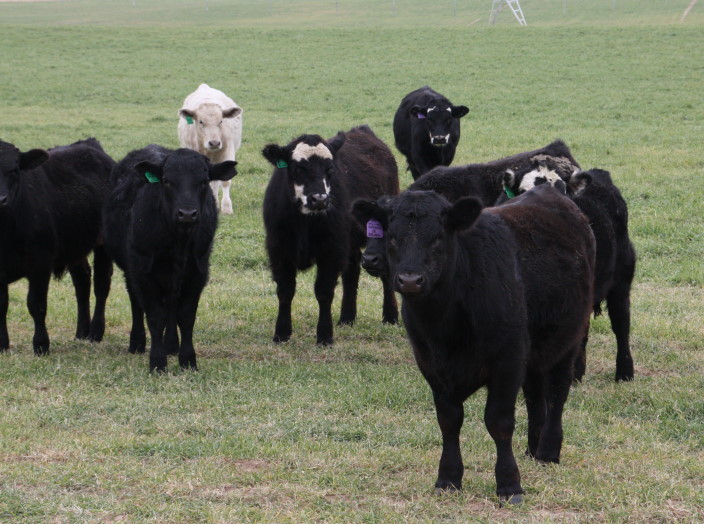
Agricultural News
Proper Nutrition a Key to Success for Replacement Heifers in Their First Breeding Season
Fri, 04 Mar 2016 20:52:16 CST
 Breeding season for replacement heifers destined for a spring-calving herd will soon be here, emphasizing the need for producers to ensure proper nutritional management of the animals.
Breeding season for replacement heifers destined for a spring-calving herd will soon be here, emphasizing the need for producers to ensure proper nutritional management of the animals.
Replacement heifers will be turned in with bulls or put on a synchronization program to be bred in April. In some cases, this means the heifers must be moved from one location to another that is closer to working facilities.
"A major consideration is to not let the heifers go on a steep downslide in energy intake as we approach the breeding season," said Glenn Selk, Oklahoma State University Cooperative Extension emeritus animal scientist and editor of the university's popular Cow-Calf Corner newsletter.
With the ending of Oklahoma's recent historic levels of drought, many cattle producers have been able to take greater advantage of improved pasture resources in managing herd nutrition requirements.
"We've had some nice rainfall throughout the winter; our subsoil moisture is good," said Tommy Puffinbarger, Alfalfa County Extension director and agricultural educator. "Many of our producers still have stockpiles of alfalfa to go with feed supplements, so folks should be in pretty good shape until spring green-up."
Much of southeastern Oklahoma, where there is some wheat pasture but many more acres of ryegrass and fescue, hit the proverbial "bump in the road" last fall.
"We had good moisture and then hit about a month-long dry spell starting in September," said Brian Freking, OSU Cooperative Extension area livestock specialist headquartered in Ada. "The growth of our cool-season forages was affected, of course, but hay supplies generally seem to be holding up well, in part thanks to mild winter weather. Livestock physically haven't needed to eat as much as past years, when they were exposed to harsher environmental conditions."
Chad Webb, Noble County Extension agricultural educator, said pastures heading into spring in his part of north-central Oklahoma generally appear to be in good condition, be they wheat, bermudagrass or native range.
"Dormant bermudagrass or native pastures will be low in energy and protein until green-up occurs later in the spring," he said. "Producers should review their plans to provide replacement heifers with needed nutrition, both for the animals' well-being and as a way to help protect their operational bottom line."
Research has shown that if heifers near the time of reaching puberty undergo a severe reduction in dietary intake of protein and especially energy, breeding success may be disappointing.
Researchers with OSU's Division of Agricultural Sciences and Natural Resources as reported in the 2001 OSU Animal Science Research Report studied the impact of short-term energy restriction on ovulation rates of cycling replacement heifers.
"The effects of acutely restricting nutrition on ovulation and metabolic hormones were evaluated in Angus x Hereford heifers," Selk said. "All the heifers were housed in individual pens in a barn and fed a diet supplying 120 percent of their maintenance requirements for protein and energy (1.2 M) for 10 days to allow time to adjust to the environment and diet."
All the heifers were determined to be cycling at the conclusion of this adjustment period. The heifers were then split into two groups. Half of the heifers were fed a diet supplying 40 percent of their maintenance requirements. The other half continued on the original diet that supplied 120 percent of the maintenance requirements. All heifers were injected with prostaglandin so they should have ovulated on about day 14 of the trial.
"Seventy percent of heifers receiving only 40 percent of their dietary requirements did not ovulate as a response to the injection, whereas all heifers in the other group experienced normal ovulation," Selk said. "Furthermore, restricting nutrient intake for 14 days prevented ovulation in a large percentage of beef heifers without altering visible body condition."
The take-away is obvious: Heifers should be managed to avoid short-term nutrient restriction and maintain normal estrous cycles.
"Research-based best management practices help cattle producers maximize the likelihood of their heifers and cows getting pregnant, staying healthy and carrying their pregnancy to term to give birth to healthy calves, which is the whole point," Freking said.
Freking added producers who have questions about best cattle management practices should contact their local OSU Cooperative Extension county office for assistance.
Oklahoma has the nation's second largest beef cow herd, according to USDA National Agricultural Statistics Service data.
WebReadyTM Powered by WireReady® NSI
Top Agricultural News
More Headlines...




